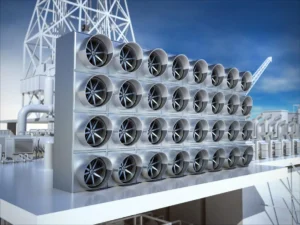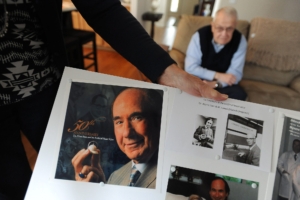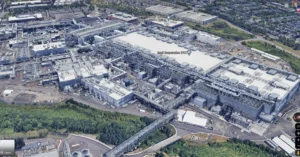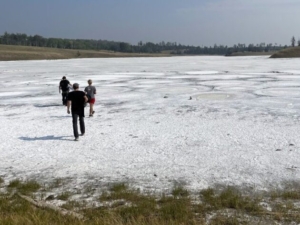
Intel Expansion, Discoveries and Innovation Show Off Region’s Science Cred
Intel received the nation’s largest CHIPS Act allocation to bolster domestic semiconductor production, which will help expand the tech giant’s Hillsboro campus with a $36 billion investment. But that was just part of the scientific news in the Pacific Northwest.
 Oregon State University scientists discovered a way to capture greenhouse gases out of the air to reuse in building construction and aiding plant growth in actual greenhouses.
Oregon State University scientists discovered a way to capture greenhouse gases out of the air to reuse in building construction and aiding plant growth in actual greenhouses.
Researchers at the University of Washington believe they found a soda lake north of Seattle that contains perfect conditions for inorganic elements to transform into organic compounds, replicating the process responsible for life on earth.
Portland State University researchers found that household cleaners can significantly remove carcinogenetic polycyclic aromatic hydrocarbons (PAHs) on clothes, windows and air filters caused by wildfire smoke.
Last year, chemists at the University of Oregon found that nanotubes, tiny circular structures intended for electronic and optical devices, could be created with atoms other than carbon, expanding their potential use to solar cells, organic light-emitting diodes and medical probes.
Linfield University was ranked as the top private research university in the Pacific Northwest. It received a $633,000 grant from the U.S. Department of Education to research digital tools for teaching elementary school mathematics and develop a toolkit for teachers.
The region has more than computer chips and software with
innovations in carbon capture, nanotubes and online math teaching.
More Than Just a Pretty Place
The Pacific Northwest is depicted as a beautiful place with rugged beaches, snow-capped mountains and endless forests. But it’s always been more than just a pretty place.
Moviegoers who saw The Boys in the Boat may have been surprised to learn that the University of Washington’s junior varsity rowing team won a national championship and an Olympic gold medal in 1936.
The electronic industry in Oregon started in a basement in Southeast Portland when a young Howard Vollum returned home from World War II and invented the modern oscilloscope – twice. His first invention was too large to get up the stairs, so he reinvented a smaller version. Electrical engineers use oscilloscopes to measure electrical phenomena and test, verify and debug circuit designs. The first Tektronix oscilloscope was purchased by the U. S. Forest Service to assist in detecting forest fires.
Bill Gates wrote his first software program at age 13 while enrolled in a private school in Seattle. Using an early computer paid for by proceeds from a rummage sale, Gates and his classmate Paul Allen wrote a computer program and helped an early computer company debug its system. That led to a path resulting in the world’s largest software company based in Seattle that reached $208 billion in sales in 2023.

In 1952, after serving in the U.S. Army Medical Corps in Korea, Dr. Albert Starr was recruited by the University of Oregon Medical School in Portland to implement an open-heart surgery program. After training a heart surgery team, Starr performed the state’s first pediatric open-heart surgery. Collaborating with retired engineer M. Lowell Edwards, Starr invented a prosthetic heart valve in 1960, followed by a surgical procedure to replace diseased heart valves. In 1985, Starr led a team that performed the first heart transplant in Oregon. The prosthetic heart valve has been credited for saving millions of lives.
The first patent for what is now called mass timber was issued in 1920 to two men from Tacoma. The process was perfected and adopted in Europe, but has found its way back to the Pacific Northwest as a way to build structures with a reduced carbon footprint by not using concrete, cement or steel. Oregon State University has established an Advanced Wood Products Laboratory to design, manufacture and test new types of mass timber. Oregon and Washington have become early adopters of this climate-friendly building technology and the Pacific Northwest has been named a Mass Timber Tech Hub.
The University of Oregon and Oregon State University are jointly pursuing a study to examine how glaciers melt when they encounter seawater in Alaska. The study is led by UO oceanographer Dave Sutherland, who found in 2019 that glaciers under the pressure of climate warming are melting 100 times faster than previous predictions. Under a National Science Foundation grant, the study will rely on OSU oceanographic and robotic technology strengths.
 Intel Expansion
Intel Expansion
The Biden administration announced last week an $8.5 billion investment, plus $11 billion in loans, to fund Intel expansion in Arizona, New Mexico, Ohio and Oregon. Company officials said they planned to spend $100 billion over the next five years in chipmaking plants, with a $36 billion budget for its Hillsboro facilities, where it develops new chips.
Microchip Technology received a $162 million CHIPS Act grant and indicated $72 million would go toward expansion of its Gresham plant.
The 2024 Oregon legislature approved $30 million to support training semiconductor workers. The 2023 legislature provided $240 million in grants and loans to support semiconductor and advance manufacturing companies and created a research and development tax credit. Business interests want to persuade the 2025 legislature to expand the tax credit.
OSU and Vanadium
OSU scientists have discovered that oxygen molecules are bonded to vanadium, they can pull carbon dioxide from the air and repurpose it. The discovery was published in the Royal Society of Chemistry’s journal in December. Vanadium is mined alongside uranium and used to strengthen steel.
May Nyman, the OSU chemistry professor who led the research, said vanadium and peroxide could be used in filters behind industrial fans to trap carbon dioxide. “It’s not a magic elixir. It’s new science. It’s a new approach. It’s a new tool,” she said. The project she leads is one of nine research efforts to identify ways to remove carbon dioxide from the atmosphere.
One of the novel ways captured carbon dioxide could be repurposed is as nourishment for plants growing in greenhouses.
 Secrets of a Soda Lake
Secrets of a Soda Lake
Finding some place on earth with the right conditions to spark spontaneous organic creation isn’t easy. A comet hitting earth could provide water and carbon. The missing ingredient would be high concentrations of phosphorous. Last Chance Lake, located in British Columbia, meets the criteria.
UW researchers say their laboratory research suggests places like Last Chance Lake represent plausible places for early life to begin. Their findings were published in the journal Nature Communications Earth & Environment.
Out With Smoke
Not only does wildfire smoke smell bad, it can be bad if the carcinogens caused by the wildfires are inhaled or consumed. PSU researchers found washing and drying smoky clothes dropped PAH exposure by nearly 50 percent and using glass cleaner on cups and windows reduced the exposure by more than 60 percent. Air filters can’t be cleaned, so researchers suggest replacing them.
Their findings were published in the journal ACS Environmental Science and Technology Engineering.
 Science of Tiny Things
Science of Tiny Things
UO professor Remesh Jasti’s chemistry lab learned how to make carbon-based molecules in the form of interlocking rings, which he says “looks almost like a chain link fence.” Jasti said, “With nanoscale adjustments, scientists could tweak the material to do exactly what they want it to do.”
Jasti says throughout human history, the discovery of a new material has been a game changer. “There was the bronze age and there was the Silicon Age. When people were able to make silicon chips and therefore computers came about. So, materials can really change the world.” Their findings were published in Nature Chemistry.




